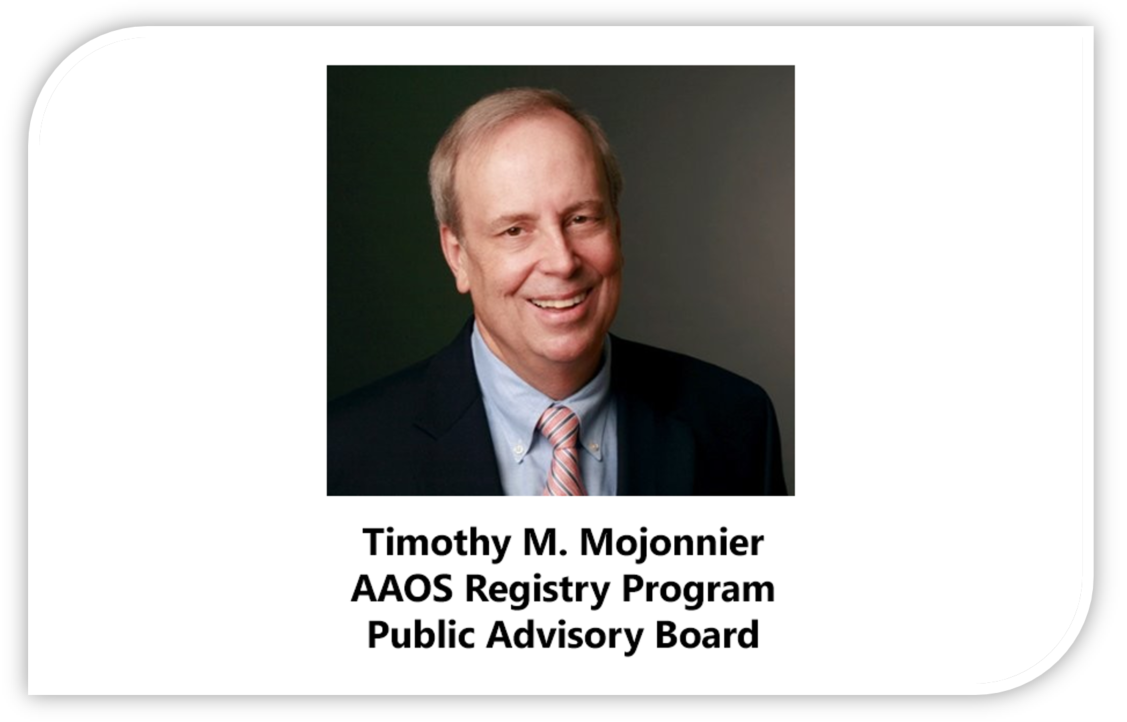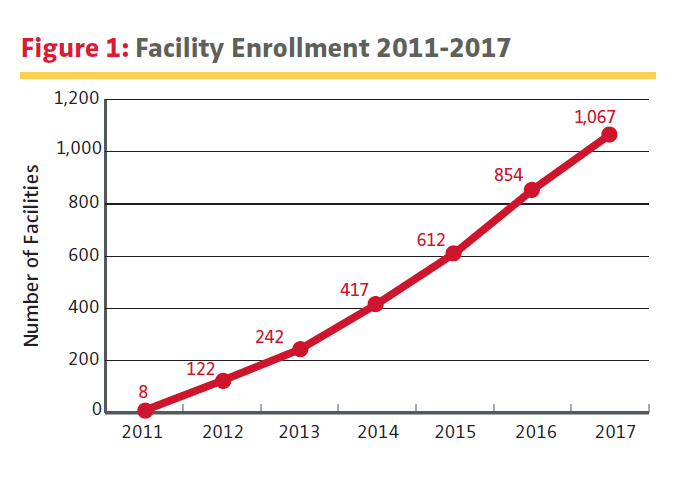A patient-reported outcomes program can help you choose the right surgeon and facility.

In this article, the AAOS Registry Program’s Public Advisory Board (PAB) member Timothy Mojonnier shares his personal experience as a joint replacement surgery patient. This article is not a substitute for physician recommendations.
Guest Blogger:
Timothy M. Mojonnier
President, Mojonnier & Associates
Educator, Loyola University
My symptoms appeared ten years ago while playing tennis. As I moved towards the net, I felt a stabbing pain in my right knee, so severe that I could barely walk. Upon returning home and getting x-rays, my orthopaedic specialist delivered the news: I had osteoarthritis. She indicated it was likely that I would eventually require a knee replacement; however, for eight years I was able to avoid the surgeon’s scalpel through a combination of physical therapy and medication.
The Surgery Decision
But during those eight years, my quality of life diminished. Sleep at night was problematic as I shifted and turned in response to the ever-increasing arthritic pain. One day my wife suggested that we take a walk around the block. Twenty yards into the walk, I could go no further. I returned home and iced my throbbing knee. That was the tipping point. The only questions that I had were these: What surgeon and which hospital should I select to do my knee replacement surgery?
The answer wasn’t obvious. I began by scouring the internet searching for ratings of surgeons and medical institutions. In the U.S. there are approximately 719,000 annual knee replacement surgeries (source: Centers for Disease Control and Prevention). Given this volume of procedures, I expected to find a wealth of customer satisfaction data that would inform my decision.
The reports available from the Internet had one thing in common: they lacked data about results. For example, the U.S. News & World Report hospital reputation survey contained information such as the friendliness of the staff. Its scope was limited in that it didn’t include data points about ambulatory surgery centers and community hospitals. In terms of physicians, I unearthed “performance measures” on criteria such as a practitioner’s ability to answer questions or the amount of time spent with each patient. Even basic information - such as the number of knee replacement surgeries performed by a given surgeon - was unavailable. I realized that I had better information about hotels and restaurants than I did about my health care choices. Lacking meaningful data, I did what most people do. I resorted to word of mouth. What I did then, I could do differently today. For example, today a patient can gain valuable information by visiting the American Academy of Orthopaedic Surgeons’ (AAOS) OrthoInfo website.
PROs Decision Support
Fortunately, I was lucky. Two years after my surgery, during a weekend in New York City with my family, I walked an average of 22,000 daily, pain-free steps. And isn’t this the goal of orthopaedic surgery, namely, improving a patient’s symptoms and functioning? Wouldn’t information about a person’s pain levels and mobility be a better measure of health care quality than knowing the average number of minutes that a doctor spends with their patients? Today, unlike when I made my surgery decision, you can find physicians and facilities that collect this data to help inform your surgery decisions.
Feedback about an individual’s symptoms and mobility is known as patient-reported outcomes (PROs), which is any information on the results of treatment that comes directly from the patients without being modified or interpreted by health professionals. In 2016, the American Joint Replacement Registry (AJRR) launched a PRO platform that captures patient-based outcome data. The information is collected through patient-reported outcome measures (PROMs), which are surveys “that capture a patient’s self-assessment of his or her health including health status (mental and/or physical), function, systems, and health-related quality of life. The PROM is a validated questionnaire that converts a symptom into a numerical score; results that a surgeon achieves - as measured by patient feedback - are quantified. As the missing link in health care quality, PROMs close the loop between the treatment received, and the resulting level of satisfaction that the patient experiences.
Choose a Surgeon and Facility That Participate in a PRO Program
In addition, the information from PROMs can be objectively analyzed and fed back to care providers. Then, health care providers can improve care for future patients. Health professionals can use PROMs to monitor individual patient outcomes, like degree of mobility experienced. With this knowledge, treatment plans can be modified to make sure patients are getting the best individualized care. PROMs facilitate a process of continuous improvement of healthcare quality - a benefit to all the stakeholders in the health care system. When de-identified PRO program outcomes are shared publicly, they can inform a prospective patient’s treatment decisions.
The cycle of continuous improvement is depicted in the following diagram:

AJRR Provides a PROs Module to Subscribers
AJRR is the central repository for PROMs data about orthopaedic hip and knee surgeries. The Registry’s goal is to capture data - both pre-operatively and post-operatively - to gain information on a patient’s functional recovery on a large scale.
But patient completion and participation rates have been slow to build at many participating sites. Reasons for this are described on page 30 of AJRR’s 2017 Annual Report: “Collecting of PROs can be a challenging issue for even the most ardent and interested institutions and providers with a mobile populace, unclear responsibility for data collection, and lack of a mandate or clear incentive at present. However, methods of embedding PRO collection into the work flow of patient care has shown promise for improving patient participation and completion rates.”
In addition to saving lives, a primary mission of health care is to improve the lives of patients. We need feedback regarding the extent to which the surgical intervention has actually improved the patient’s symptoms.
Motivating Patients to Participate in PRO Surveys
The goal of AJRR is to improve orthopaedic care through data. To realize this goal, in addition to the systemic, top-down changes to the way surveys are distributed and data is collected, the onus is also on patients to complete the surveys that they receive. My advice, as a past patient, is to participate in the survey from your health provider. Take a few minutes and fill it out. The information that you provide will improve the quality of health care that we all receive.
NOTE: This blog shares a single patient experience and is not intended as a substitute for professional medical advice. You can view the AAOS Terms, Conditions and Disclaimers here. AJRR is a part of the AAOS Registry Program.
References
Porter, M. E. & E.O. Teisberg, (2006). Redefining Healthcare, Boston, MA., Harvard Business School Press.
“Patient-Reported Outcomes Summit for Total Joint Arthroplasty Report” August 31, 2015, The Journal of Arthroplasty. https://www.arthroplastyjournal.org/article/S0883-5403(15)00894-3/pdf
“Patient Reported Outcomes (PROs) in Performance Measurement,” 1/10/13. National Quality Forum. ISBN 978-1-933875-44-6
Theresa Weldring and Sheree M.S. Smith “ 2013; “Patient-Reported Outcomes (PROs) and Patient-Reported Outcome Measures (PROMs),” Health Service Insights, August 4, 2013
AJRR’s Patient-Reported Outcome Measures Guide, http://www.ajrr.net/images/downloads/Data_elements/AJRR_PROMS_GUIDE_2016_FINAL_4-5_FINAL.pdf
For information about the AAOS RegistryInsights™ platform, speak with a Registry Engagement Associate at (847) 292-0530 or Request A Demo today!
Be sure to leave a comment in the form below!



